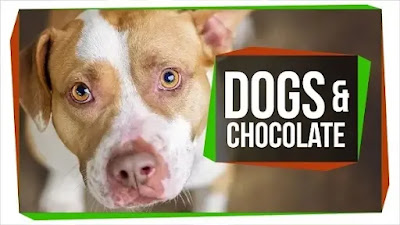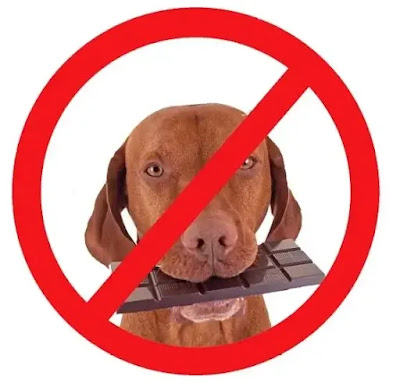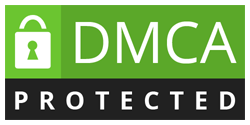Dogs have been humans' loyal companions for thousands of years, and it's not hard to see why. They are loyal, loving, and provide endless joy and entertainment. In fact, according to the American Pet Products Association, there are an estimated 90 million dogs in households across the United States alone. These furry friends have become part of our families and have become an integral part of our daily lives.
Despite their lovable nature, dogs can also be susceptible to certain health risks, particularly when it comes to their diet. While dogs are omnivorous animals and can eat a variety of foods, there are certain human foods that can be toxic to them. Among these foods, chocolate is one of the most well-known examples of a substance that can be dangerous to dogs.
In this article, we will explore why chocolate is toxic to dogs and other foods that can be harmful to them. We will also provide tips for keeping your pet safe from these substances and what to do if your dog has ingested them. By understanding the potential dangers and taking steps to prevent exposure, you can help ensure the health and safety of your furry friend.
The Reason Why Chocolate Is Toxic to Dogs
Chocolate contains two substances that can be toxic to dogs: theobromine and caffeine. Theobromine is a bitter alkaloid that is similar in structure to caffeine, but is much more potent. It is found in the cocoa solids that are used to make chocolate, and is present in higher concentrations in dark chocolate and baking chocolate compared to milk chocolate.
1. How Theobromine and Caffeine Affect Dogs
When dogs consume chocolate, theobromine and caffeine are absorbed into their bloodstream and start to have an effect on their body. Dogs are unable to metabolize theobromine and caffeine as efficiently as humans, which means that these substances can build up in their system and cause a range of health problems.
Theobromine and caffeine stimulate the central nervous system and can lead to a variety of symptoms, ranging from mild to severe. The severity of the symptoms depends on the amount of chocolate ingested and the size of the dog. Smaller dogs are at greater risk of suffering from severe symptoms and complications, as they are more susceptible to the toxic effects of theobromine and caffeine.
2. Common Symptoms of Chocolate Toxicity in Dogs
Some of the most common symptoms of chocolate toxicity in dogs include vomiting, diarrhea, restlessness, hyperactivity, rapid breathing, muscle tremors, seizures, and even death in severe cases.
In general, symptoms of chocolate toxicity will start to appear within a few hours of ingestion and can last for several days. The severity of the symptoms will depend on the amount and type of chocolate consumed, as well as the size and health of the dog.
If you suspect that your dog has ingested chocolate, it's important to seek veterinary care immediately. Your veterinarian may induce vomiting or administer activated charcoal to help absorb the toxins in your dog's system. In severe cases, hospitalization and supportive care may be necessary.
3. Factors That Affect Chocolate Toxicity in Dogs
Several factors can affect the toxicity of chocolate in dogs. The amount and type of chocolate consumed are the most significant factors, with dark chocolate and baking chocolate being the most dangerous. The size and health of the dog are also important, as smaller dogs and dogs with underlying health conditions are more susceptible to the toxic effects of theobromine and caffeine.
Age can also play a role in chocolate toxicity, with puppies and older dogs being more vulnerable. Additionally, individual dogs may have different levels of sensitivity to theobromine and caffeine, which can impact their reaction to chocolate consumption.
It's important to keep chocolate and other foods that are toxic to dogs out of reach to prevent accidental ingestion. Understanding the risks and symptoms of chocolate toxicity can help you to identify potential problems and seek veterinary care as soon as possible to protect your furry friend's health and well-being.
Other Foods That Are Toxic to Dogs
Chocolate is not the only food that can be toxic to dogs. In fact, there are many common human foods that can be harmful or even deadly to dogs. It's important to be aware of these foods and keep them away from your furry friend to prevent accidental ingestion.
1. Grapes and Raisins
Grapes and raisins are known to cause kidney failure in dogs, even in small amounts. The exact mechanism of toxicity is not fully understood, but it's believed to be related to a compound found in grapes and raisins that can damage the kidneys. Symptoms of grape or raisin toxicity in dogs include vomiting, diarrhea, lethargy, and increased thirst and urination.
2. Onions and Garlic
Onions and garlic are members of the allium family of plants and contain compounds that can damage red blood cells in dogs. This can lead to anemia and other serious health problems. Symptoms of onion or garlic toxicity in dogs include weakness, lethargy, vomiting, diarrhea, and difficulty breathing.
3. Avocados
Avocados contain a substance called persin, which can be toxic to dogs in large amounts. Persin is primarily found in the leaves, fruit, and bark of the avocado tree, but is also present in small amounts in the flesh of the avocado itself. Symptoms of avocado toxicity in dogs include vomiting, diarrhea, and difficulty breathing.
4. Other Foods
Other foods that are toxic to dogs include alcohol, caffeine (in addition to chocolate), macadamia nuts, and xylitol (a sugar substitute found in many sugar-free gums and candies). Some human medications can also be harmful to dogs, so it's important to keep all medications out of reach.
5. Common Symptoms of Food Toxicity in Dogs
The symptoms of food toxicity in dogs can vary depending on the type and amount of food ingested, as well as the size and health of the dog. Common symptoms include vomiting, diarrhea, abdominal pain, lethargy, and loss of appetite. In severe cases, food toxicity can lead to seizures, coma, and even death.
If you suspect that your dog has ingested a toxic food, it's important to seek veterinary care immediately. Your veterinarian may induce vomiting or administer activated charcoal to help absorb the toxins in your dog's system. In severe cases, hospitalization and supportive care may be necessary.
It's important to be aware of the foods that are toxic to dogs and take steps to prevent accidental ingestion. Keeping these foods out of reach and providing safe, dog-friendly alternatives can help to protect your furry friend's health and well-being.
What to Do If Your Dog Eats Chocolate or Other Toxic Foods
If you suspect that your dog has eaten chocolate or another toxic food, it's important to take action immediately. The faster you act, the better the chances of a positive outcome for your furry friend.
1. Seek Veterinary Care Immediately
The first thing you should do if you suspect that your dog has ingested a toxic food is to seek veterinary care immediately. Even if your dog is not showing any symptoms yet, it's important to have them evaluated by a veterinarian as soon as possible. In some cases, symptoms may not appear until several hours after ingestion.
When you bring your dog to the veterinarian, be sure to provide as much information as possible about the type and amount of food ingested, as well as any symptoms your dog may be experiencing. This will help your veterinarian to determine the best course of action.
2. Tips for Being Prepared
It's a good idea to be prepared for a dog emergency, including accidental ingestion of toxic foods. Here are some tips for being prepared:
- Keep the phone number of your veterinarian or an emergency veterinary clinic on hand, along with any other important phone numbers (such as the ASPCA Animal Poison Control Center).
- Keep a first-aid kit for your dog on hand, including items such as gauze, bandages, and hydrogen peroxide (to induce vomiting if instructed to do so by a veterinarian).
- Consider taking a pet first-aid and CPR class to learn how to respond to emergencies.
3. Additional Considerations
If your dog has ingested a toxic food, it's important to avoid inducing vomiting or administering any medications without first consulting with a veterinarian. Some substances, such as gasoline or bleach, can cause additional harm if vomited up.
In some cases, your veterinarian may need to hospitalize your dog for observation and supportive care. Treatment may include intravenous fluids to help flush the toxins out of your dog's system, as well as medications to manage symptoms such as vomiting or seizures.
4. Understanding Chocolate Toxicity in Dogs
It's important to understand that not all types of chocolate are equally toxic to dogs. Dark chocolate and baking chocolate contain higher levels of theobromine and caffeine than milk chocolate, which means that they are more dangerous for dogs to ingest. However, any type of chocolate can be harmful in large enough quantities.
Symptoms of chocolate toxicity in dogs include vomiting, diarrhea, increased thirst, restlessness, and seizures. In severe cases, chocolate toxicity can even be fatal.
If you suspect that your dog has ingested chocolate, it's important to be able to estimate the amount consumed. This can help your veterinarian to determine the appropriate course of action. As a general rule, the more chocolate your dog has eaten, the more dangerous the situation.
5. Other Toxic Foods for Dogs
In addition to chocolate, there are several other foods that are toxic to dogs. Grapes and raisins, for example, can cause kidney failure in dogs. Onions and garlic can damage a dog's red blood cells, leading to anemia. Avocado can cause vomiting and diarrhea in dogs. Even foods that are safe for humans, such as nuts and certain fruits, can be dangerous for dogs.
Symptoms of toxicity from these foods can vary depending on the type and amount consumed. If you suspect that your dog has ingested a toxic food, it's important to seek veterinary care immediately.
If you suspect that your dog has ingested a toxic food, it's important to seek veterinary care immediately. Being prepared for a dog emergency can help you to act quickly and effectively, potentially saving your furry friend's life. Understanding the dangers of chocolate and other toxic foods, as well as the importance of prevention, can also help keep your dog safe and healthy.
Preventing Chocolate and Other Food Toxicities in Dogs
It is always better to prevent chocolate and other food toxicities in dogs than to treat them once they occur. There are several things you can do to keep your dog safe:
- Keep chocolate and other toxic foods out of reach: Dogs have a great sense of smell and can easily detect the presence of chocolate and other toxic foods in your home. Therefore, it is important to keep these foods out of reach by storing them in high cabinets or in a pantry that can be securely closed. This will also prevent your dog from accidentally ingesting these foods.
- Educate family members and guests: It is important to educate all members of your household, as well as any guests, about the dangers of feeding dogs chocolate and other toxic foods. Make sure everyone is aware of what is safe and what is not, and make sure they know to keep all food out of your dog's reach.
- Offer safe alternatives: If you want to give your dog a treat, there are plenty of safe alternatives to chocolate and other toxic foods. Some safe options include carrots, apples, bananas, and green beans. You can also find dog treats at your local pet store that are specifically made for dogs and are safe for them to eat.
- Be aware of other household items that can be toxic to dogs: In addition to chocolate and other toxic foods, there are many other household items that can be toxic to dogs. These include medications, cleaning products, plants, and certain types of human food. Be sure to keep all of these items out of your dog's reach, and educate yourself on what is safe and what is not.
- Be vigilant during holidays and special occasions: During holidays and special occasions, there are often more opportunities for dogs to accidentally ingest toxic foods. For example, during Halloween, there may be chocolate candy left lying around, and during Thanksgiving, there may be foods like onions and garlic in dishes that dogs could get into. Be especially vigilant during these times, and make sure all food is safely stored away from your dog.
- Train your dog to "leave it": One way to help prevent your dog from eating something they shouldn't is to train them to "leave it" when you tell them to. This can be a helpful command when your dog is about to eat something they shouldn't, like a dropped piece of chocolate. With practice, your dog will learn to leave the item alone when you give the command.
- Keep garbage cans securely closed: Dogs are notorious for getting into the garbage and eating things they shouldn't. To prevent this, make sure your garbage cans have tight-fitting lids and are kept out of your dog's reach. You can also consider getting a dog-proof garbage can if your dog is particularly persistent.
- Check labels and ingredients: When buying food and treats for your dog, be sure to check the labels and ingredients to make sure they are safe. Some foods, like peanut butter, may contain xylitol, which is toxic to dogs. Other ingredients, like grapes and raisins, can be hidden in trail mix or granola bars. Be sure to read labels carefully and avoid any foods that are not safe for your dog to eat.
By taking these extra precautions, you can help ensure that your dog stays safe from food toxicities and other harmful substances. Remember, prevention is always better than treatment, and a little extra effort can go a long way in keeping your furry friend healthy and happy.
👉 Read more posts with the same topic
Conclusion
In conclusion, dogs are popular pets and are often treated like members of the family. However, it's important to remember that dogs have different nutritional needs than humans and can be sensitive to certain foods and substances that are safe for us. Chocolate is one such substance, and its toxicity to dogs can lead to serious health problems, including seizures and even death.
It's also important to be aware of other foods that are toxic to dogs, including grapes, raisins, onions, garlic, and avocados. Knowing the symptoms of toxicity and taking prompt action if your dog ingests something harmful can make a big difference in their outcome.
By taking steps to prevent your dog from ingesting toxic foods and substances, you can help ensure that they live a long and healthy life. This includes being vigilant during holidays and special occasions, training your dog to "leave it," keeping garbage cans securely closed, and checking labels and ingredients.
As responsible dog owners, it's our duty to keep our pets safe and healthy. By following the tips outlined in this article, you can help ensure that your furry friend stays happy, healthy, and free from the dangers of toxic foods and substances.









0 Comments